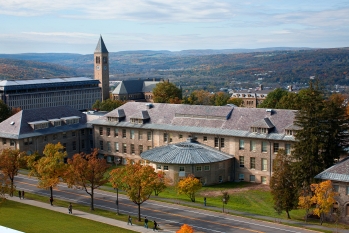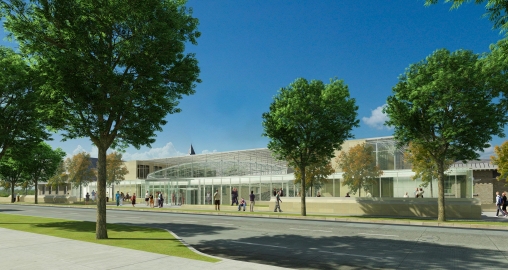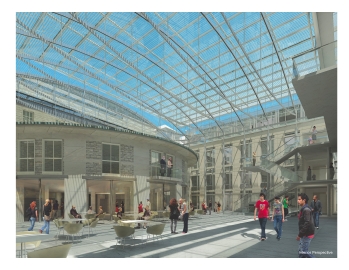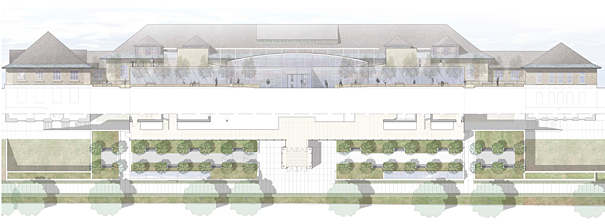ARTS AND HUMANITIES
'Magnificent' new humanities building to be gateway to the Arts Quad

The transparent glass facade will allow views into the new atrium space from Baker Lab, Rockefeller Hall, the East Slope Lawn across East Avenue, and the sidewalks along East Avenue.

Currently, the rotunda and the rear of Goldwin Smith Hall are visible from East Avenue, but there is no entrance to the building. See larger image
"A magnificent new building for the humanities" will soon provide a gateway to the Arts Quad, President David Skorton announced in October, and will recognize the vitality and importance of the humanities at Cornell. It will create a space that transforms the experience of the Arts Quad, the emotional heart of the campus, by promoting student connections with the liberal arts and the humanities in particular.
The building also will help the College of Arts and Sciences meet the growing need for more faculty office and classroom space. Groundbreaking is targeted for summer 2013 with a projected opening in 2015.
The building will be "the first on our campus for the humanities since Goldwin Smith [Hall] opened in 1905," said Skorton, who made the announcement in front of a packed Statler Auditorium at the Trustee Council Annual Meeting.

Additional renderings of the new Humanities Building. Goldwin Smith Hall's rotunda will be modified to open into the atrium of the new building.
Located between Goldwin Smith Hall and East Avenue, the new building will provide some 33,250 square feet of new space, including a 330-350 seat auditorium, the largest on the Arts Quad, and many new offices and programmable areas. A 7,700-square-foot, expansive day-lit atrium will offer an iconic indoor space for faculty and students to gather. Its innovative and sustainable design will be a major architectural addition to the Cornell campus.

Goldwin Smith Hall's rotunda will be modified to open into the atrium of the new building. See larger image
The building is expected to cost $61 million and "we're doing it completely by philanthropy," Skorton said. At the Oct. 21 meeting, he told an applauding audience that fundraising for the project is "75 percent of the way there" and "we're going to get all the way there by Jan. 1."
"This spectacular building will symbolically and physically welcome the rest of the campus to participate in the humanities and arts at Cornell," said Peter Lepage, the Harold Tanner Dean of the College of Arts and Sciences.
"We've been fortunate to have received a lead gift of $25 million from a donor who wishes to remain anonymous, and it was that tremendous expression of support that allowed us to move forward with the project," said Skorton. "I am extraordinarily grateful for this commitment to Cornell and to the humanities, which comes at a critical point in time."
Among the project's other lead donors is Tom Groos '78 and his family, of Hastings, Mich. Groos, chairman of Minimax-Viking and a partner of City Light Capital, says that contributing to the new humanities building was "an obvious choice." "We're very excited about our donation going to a place where we know it will be well spent on things that will have a positive impact on the future of the country and the world," he said.


Skorton publicly thanked the anonymous donor and Groos and his family at the meeting; he also praised Lepage for his leadership in "bringing us to this milestone."
In the 106 years since Goldwin Smith Hall opened, the humanities faculty in the College of Arts and Sciences has grown from 30 to well over 227 – an increase of more than 700 percent. The spectacular success of Cornell's faculty renewal hiring initiative, especially involving humanists, has made the need for faculty offices and student classrooms even more critical, says Lepage.
The new building includes approximately 124 office-sized spaces that can be used for single faculty offices or could be combined to provide department offices, meeting rooms or conference rooms. "We are still exploring the best arrangement, but we do know that the building will include the Department of Romance Studies, in order to bring all the literature departments into one building," says Lepage.
The building is planned to be LEED Platinum certified, with cutting-edge environmental technologies that include an extensive green roof system and variable air volume technology to provide energy-efficient ventilation.
In order to preserve Cornell's iconic viewscape, the roofline of the new building will not be visible from the Arts Quad. An external promenade will run its entire length along East Avenue, providing tree-lined walking and gathering spaces.
A large café will occupy the lower level of Goldwin Smith's rotunda, which will become part of the atrium. This new dining location will have extensive seating and feature a popular menu.
The architectural design firm is Boston-based Koetter, Kim and Associates, whose founders are both Cornell alumni. The firm also designed the recently completed Physical Sciences Building.
Linda B. Glaser is a staff writer for the College of Arts and Sciences.